There is a rainbow of horse coat colors.
Some are more common, some are rare, many are pretty, some are gorgeous.
Come along with me as we go over the basics of all the beautiful patterns, shades, variations, and colors of the equine world. At the end of this post, I will answer your questions that are commonly asked about horse coat colors and patterns.
Table of Contents
Base Horse Coat Colors
All horse colors originate from 3 base colors which you are about to discover if you didn’t already know.
The basic coat colors of a horse are bay, chestnut, and black. White is not considered a base color which is actually the absence of pigmentation in the horse’s skin and coat. Brown is sometimes said to be a base coat color but it’s not, actually technically there are only 2 base colors red(chestnut) and black.
Bay and brown are modifications of black which you are just about to learn about.
Bay | Base Horse Coat Color

Bay is technically a modification of black with the modifying agouti gene also known as ASIP. Although it is still widely considered a base color.
Bay horse bodies are a reddish, brown color with the black color pushed out to the horse’s mane and tail, legs, tips of ears and muzzle. These areas are called the points of the horse.
The dominant agouti allele (A) functions normally to restrict black pigment to the points of the horse, and the recessive (a) allele is unable to restrict pigment to the points of the horse and results in a uniform distribution of black pigment across the body.
vgl.ucdavis.edu
Brown is a generic term most non-horsey people use often for bay or chestnut variations. There is in fact a color called seal brown which stems as a variation under the base color bay.
Chestnut | Base Horse Coat Color

The red base coat or chestnut coat color are reddish-brown pigments with the mane, tail and legs the same shade or of a lighter color. The chestnut color has absolutely no black hairs in the coat.
The red coat is due to the allele “e” a mutation of the wildtype allele that is considered recessive.
A recessive allele is a variety of genetic code that does not create a phenotype if a dominant allele is present. In a dominant/recessive relationship between two alleles, the recessive allele’s effects are masked by the more dramatic effects of the dominant allele.
biologydictionary.net
Chestnut horses are very common but come in many shades. They often get confused with different colors. People can mix up darker chestnuts for black or brown and lighter chestnuts for palomino.
Black | Base Horse Coat Color
The black base color is entirely black with no brown highlights on the face or body. Although black horses can bleach out in the sun.
The bleached areas turn a reddish-brown, which is rightly called a “sun bleach.” Many people sometimes get confused when trying to identify a black horse that is bleached by the sun. This is because a bay, seal brown or liver chestnut, can look similar to a sun bleached black horse.
To differentiate between a black and “brown” horse, a true black horse will have black hairs around their eyes and muzzle.
There are some breeds of horses and ponies that are almost singly black, such as the Friesian.
What Is The Difference Between A White & Gray Horse?
Many people will look at a horse with a white coat can call it a white horse but not all white looking horses are actually considered white.
Some horses look white but are more correctly known as gray or grey (either one.)
Let’s go over the characteristics and differences between white and grey horse colors so you know a little bit more and can identify the differences.


| Grey Horse | White Horse | |
| Color | Gray horses can sometimes but not always have a pure white hair coat, making them look like white horses. | A white horse is pure white, has a lack of pigment in the skin and coat. |
| Skin Color | Grey horse’s skin is a dark color, grey or blackish, which is noticeable around the muzzle and eyes. | White horses have light pink colored skin. |
| Eye Color | Grey horses typically don’t usually have light-colored eyes. | White horses can have either dark or light-colored eyes. |
| Birth Color | Grey horses are born dark, whatever their base color coat is. The graying gene lightens their coat with white hairs as they age. | They are born with a white coat and pink skin. |
| Other Facts | Grey horses have different variations of coat colors depending on the base coat, and also what stage they are at in the graying process, which you will learn more about further down the post. | White horses can look albino but would only be considered actually albino if they have pink eyes. |

Bay Horse Color Variations
Here is a list of color variations that come from the base coat color bay. Keep going to see pictures and descriptions for each of the colors.
For a quick look at the bay color variations:
- Blood bay
- Cherry bay
- Dark bay
- Seal brown
- Wild bay
- Bay Dun
- Bay Roan
- Buckskin
- Perlino
- Amber Champange
- Pangare Bay
- Bay Silver
- Rose Grey
Blood Bay Horse Color & Cherry Bay Horse Color

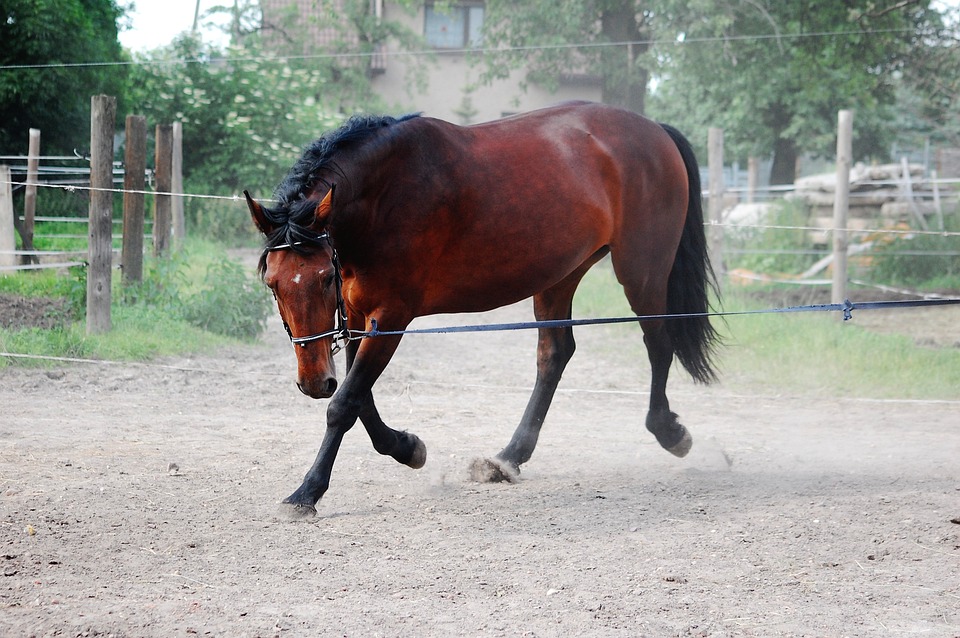
Blood bay and cherry bay are similar colors with slight differences.
Both blood bay and cherry bay are vivid variations of the bay color. The colors are vibrant and bright compared to the typical bay color.
Blood bay is a dark red shade that almost has a purple hue to the color.
The cherry bay is a little bit lighter more of a medium red shade.
Dark Bay Horse Color

The dark bay has more black in the coat. Sometimes dark bays can look almost black. This is because the black color hasn’t been pushed out as much as other bay horses.
A dark bay will have brownish-red hairs under the eyes, around the muzzle, behind the elbow, and in front of its stifle.
This is the case whether they are a lighter dark bay or an almost black looking dark bay with more dark hairs.
Seal Brown Horse Color

Seal brown is often confused with dark bay.
They look very similar.
However, a seal brown horse has a dark brown or blackish coat with lighter brown or tannish highlights around the muzzle, eyes, in front of the stifle and behind the elbows.
A dark bay horse does not have these features.
Wild Bay Horse Color

This is a more primitive type of bay color.
A wild bay horse looks like a regular bay horse. But often, a wild bay is lighter in color, and the black on the legs doesn’t reach past their knees or their hocks.
It can even ends down by the ankles. This usually happens to horses with the pangare gene, which makes the horse’s muzzle, belly, inner forearms, and thighs lighter.
Pangare Bay Horse Color

Pangare comes in bay and chestnut and is more of a trait or pattern than it is a color.
There are light colored highlights around the muzzle, eyes and under the belly. The bay pangre will still have the black points.
Buckskin Horse Color

Buckskin is a dilution of bay base color with 1 cream allele present.
The buckskin color is a pale cream to golden tan. Similar to the tan color of a wild buck. They retain the black points on their legs, mane, tail, muzzle and ear tips.
Their skin and eyes are dark, as well.
Bay dun horses easily get confused with buckskin horses. Read the following post to get a really solid idea of the differences between the two: Learn 10 Facts, Differences & Color Shades Of Buckskin & Dun Horses
Perlino Horse Color

Perlino is also known as pearl.
It’s a cream gene dilution like buckskin, but it is the next step after buckskin.
Perlino’s have 2 creme dilution alleles on a bay base.
They are often confused with albino horse’s because of there pinkish tint to the skin and coat color.
Perlino’s eyes are typically light in color.
Amber Champagne Horse Color
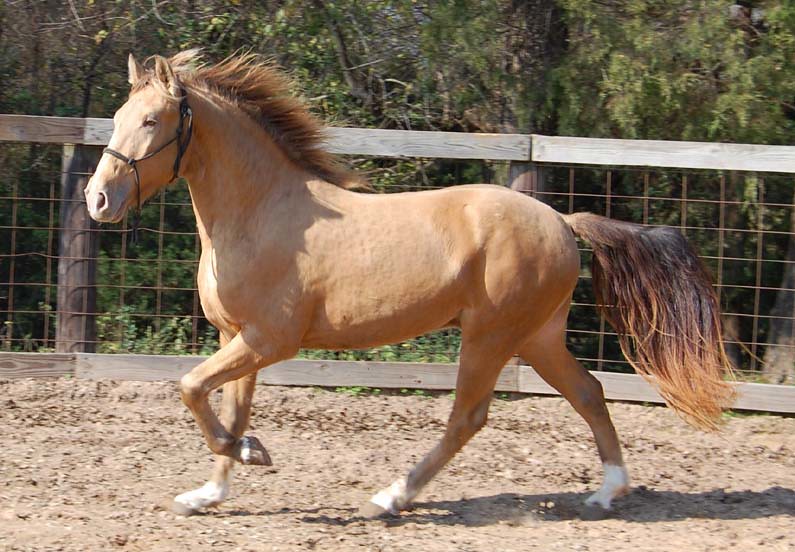
The champagne gene turns a bay horse into an amber champagne colored horse.
The amber champagne color is similar to the color of amber and can come in slightly different shades.
Many times they will have dark tan or brown points instead of the normal black that is seen in bay horses. However the mane and tail is a similar color to the body but tends to be slightly darker.
A lighter colored variation of an amber champagne horse will be missing the darker points and the lower legs will be the same color as their body.
Silver Bay Horse Color
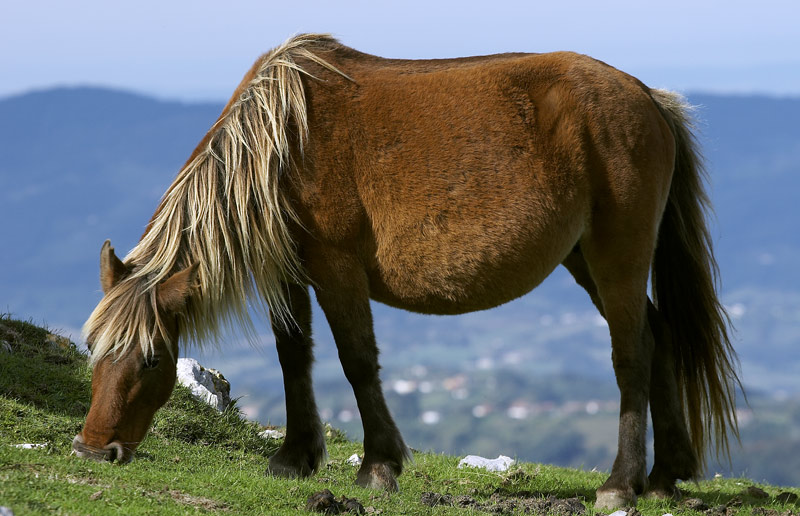
With the silver gene a bay horse becomes a silver bay.
The silver gene strips the pigment in the black mane and tail to a bleached color all the way to a white silvery color.
Sliver bay horses have light to dark bodies with brown or grey points. Many times these points are barely visible.
Flaxen chestnut horses are commonly confused for silver bay horses. To tell if a foal is a flaxen chestnut or a sliver bay many look for the silver eye lashes and the horse’s pedigree to figure it out.
Bay Dun Horse Color

Dun horses have primitive markings.
The bay dun is a tan color with a dorsal stripe down the back, and dark legs. The mane and tail are dark with varying amounts of frost on either side of the mane and tails base.
There are also small horizontal stripes on the legs called leg bars and sometimes they may have shoulder bars or a transverse stripe as well. Bay duns often get confused with palominos and buckskins.
A common breed you can find with dun genes is the fjord. You can find fjords in different shades of the dun coloring.
Bay dun horses are commonly confused with buckskins check out the following post to compare buckskins and dun horses against each other. Learn 10 Facts, Differences & Color Shades Of Buckskin & Dun Horses
Bay Roan Horse Color

A bay horse with the roan gene, is a bay roan.
In a bay roan white hairs are dispersed throughout the bay colored body.
The head and lower legs tend to stay dark and the horse tends to still have a black mane and tail, legs, muzzle and ear tips.
Rose Grey Horse Color

A rose grey horse is born a bay or chestnut.
The rose grey has a pinkish tint to the coat, hence the name. This is from the bay or chestnut hairs, that are present.
Eventually, like all greys the horse’s coat becomes a whiter color with age.
Chestnut Horse Color Variations
Here is a list of color variations that come from the base coat color chestnut. Keep going to see pictures and descriptions for each of the colors.
For a quick look at the variations of the chestnut base color:
- Sorrel
- Liver Chestnut
- Chestnut Pangare
- Palomino
- Cremello
- Gold Champagne
- Flaxen Chestnut
- Red Dun
- Red Roan
- Flea-Bitten Grey
Liver Chestnut Horse Color

Liver chestnut has the same recessive gene as regular chestnut but is a more vivid darker version.
The liver chestnut has a chocolate, brownish color instead of the typical red or rust color you see in a chestnut horse.
The legs, mane and tail are the same color.
Sometimes people confuse liver chestnut horses with dark bay, seal brown, and black.
Sorrel Horse Color

A sorrel colored horse is genetically the same as a chestnut horse. Technically sorrel is synonymous with chestnut.
Sorrel is an ambiguous term.
Different people have different opinions on what sorrel means.
Western riding folk tend to use the term sorrel more often than chestnut. Where as, sorrel is a seldom-used term by english riding folk, chestnut is much more commonly used by english riders.
Certain regions and breed registries separate the terms chestnut and sorrel. They define sorrel as a lighter coppery shade, where as chestnut more of a browner rust color.
Chestnut Pangare Horse Coloring

A common breed of horse to have this coloring is the Haflinger and they also tend to have a flaxen mane and tail.
The pangare coloring is when the belly, muzzle, flanks and sometimes legs are a lighter color than the rest of the body.
The mane and tail is often lighter in chestnut horses with the pangare trait. It is thought that flaxen manes and tails have a connection to the pangare trait.
Palomino Horse Color

Palominos are a dilution of the chestnut coat color with one allele of the cream gene.
Palominos have a yellow to golden coat like the color of a gold coin and can come in lighter or darker shades. Their mane and tail are a white or light cream color.
Palominos have dark skin and brown eyes but sometimes they can be born with amber or lighter brown eyes.
Palominos sometimes get confused with flaxen chestnuts, cremello, champagne gene, buckskins, duns and sometimes silver bays.
Like the buckskin a palomino is created with 1 allele of the cream gene, except buckskin is on a bay base and a palomino is off of a chestnut base.
Want to learn all about Palominos? Then check out the following post: 27 Interesting Palomino Horse Facts With Beautiful Pictures & Some Extras

Cremello Horse Color

One cream gene allele with a palomino will cause a further loss of pigment and turn a palomino color into a cremello color. Two copies cream gene alleles will turn a chestnut into a cremello.
The Cremello horse has a beautiful cream color with a white mane and tail and they can have white face and leg markings.
Another trait of the Cremello horse is their pink skin and blue eyes.
Gold Champagne Horse Color
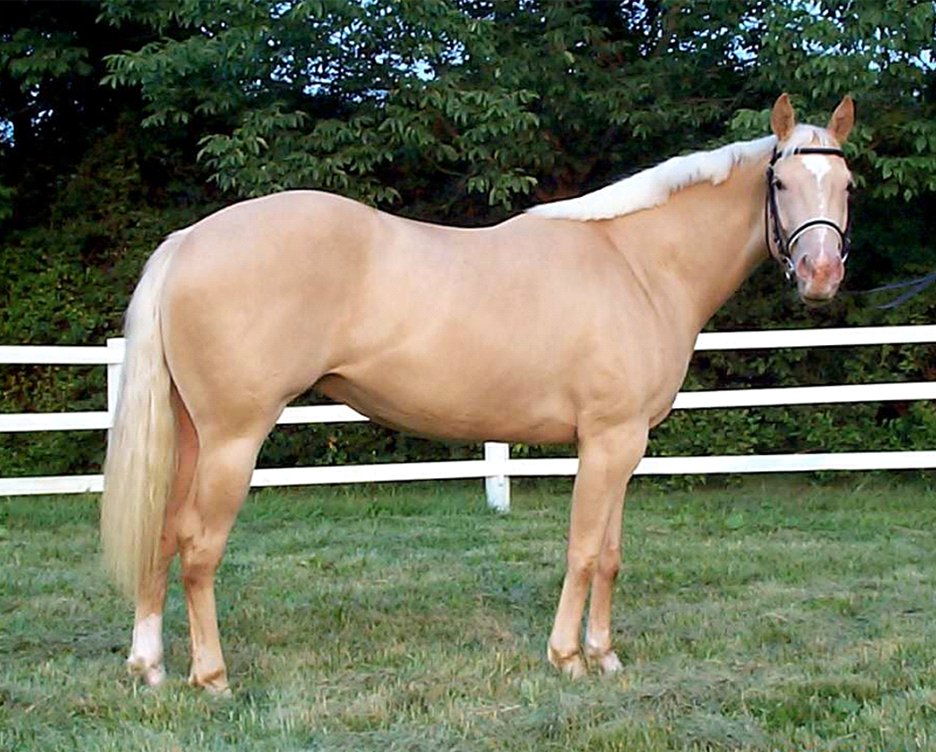
One or two champagne genes on a chestnut color creates a gold champagne color coat.
Gold champagne horse’s vary from a golden body to a uniform apricot color. They usually have a flaxen, almost white mane and tail, but they can also have a mane and tail that matches the body.
Gold champagne horses look very similar to a palomino aside from there pinkish skin, lighter colored hazel eyes and pink freckling on the skin.
Often these horses are registered as palominos with the PHBA (Palomino Horse Breeders of America) despite not being a palomino and the difference in the skin. Often the term “mottled” in used under skin color.
Flaxen Chestnut Horse Color

The silver gene doesn’t affect chestnuts because it only affects black pigment, but chestnuts can have a flaxen mane and tails.
A flaxen chestnut is only describing the chestnuts mane and tail.
The flaxen color is a bleach blonde, light cream or whitish color.
Red Dun Horse Color

The dun gene also known as the “dun factor” on a chestnut horse dilutes the color and create a red dun.
Red duns are typically light colored chestnuts with dorsal stripes, leg bars and sometimes cobwebbing and shoulder bars across the withers. The color can vary from a rich red to a light peachy color.
The dorsal stripe will always be a darker shade than the body. All the primitive dun markings on a red dun will be a reddish color. They also tend to have a darker head than the rest of their body.
A red dun can have a flaxen mane and tail but don’t always.
Red Roan Horse Color

A red roan is a chestnut horse with the roan gene. In the past red roan used to include both chestnut and bay roan horses but now it is solely a chestnut base.
The red roan color is white hairs mixed throughout the chestnut coat.
There are other names for red roans as well depending on the shade of chestnut, the roaning is mixing with.
A light chestnut with roaning has a pinkish tint and is called strawberry roan.
A palomino or a very light chestnut color with roaning is called a honey roan.
A dark chestnut with roaning is called a lilac roan, which is the most rare.
white hairs mixed throughout the coat. Sometimes lighter colored red roans are called strawberry roans.
Flea-Bitten Grey Horse Color

Flea-bitten grey horses are can be born chestnut, bay or black. The flecks are in the color of the base coat. These flecks typically develop as in adulthood as they age.
Not all grey horses become flea-bitten grey.
To learn more about flea-bitten gray, the graying process and gray horse genetics check out the following post: What Is A Flea Bitten Grey Horse? Grey Horse Breeds, Facts, Colors & Photos
Black Horse Color Variations
Here is a list of color variations that come from the base coat color black. Keep going to see pictures and descriptions for each of the colors.
For a quick look at the black color variations:
- Jet Black
- Faded Black Horse Color
- Bleached Out Black Horse Color
- Smokey Black Horse Color
- Classic Champagne Horse Color
- Silver Dapple
- Grulla
- Blue Roan
- Steel Grey
Jet Black
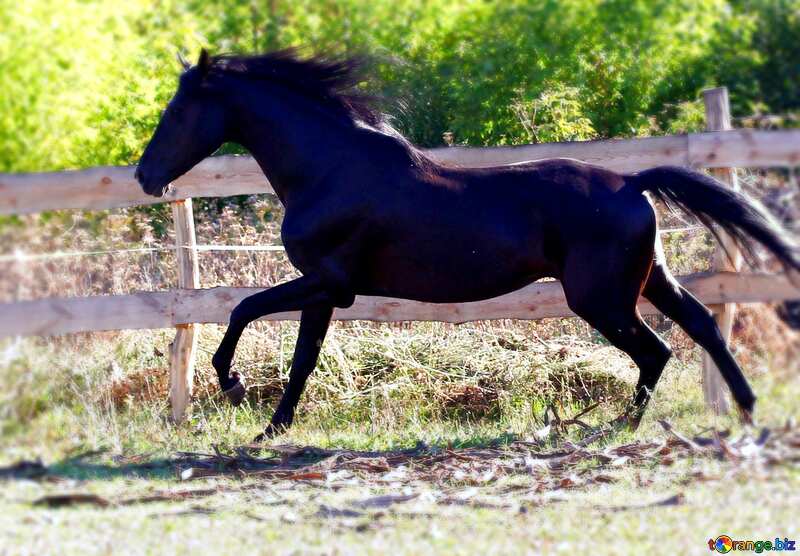
Jet black coat color is a black coat color that may have a bluish tint.
There are black horses that fade out in the sun and some that do not.
A jet black horse coat does not fade out in the sun. When they are born they are jet black in color as well unlike some black horses that are born mouse grey or a dun like color.
Faded Black Horse Color

Many people confuse faded black horses to be brown horses.
Most black horse coats fade in the summer sun, with some brownish areas.
This is unlike horses that keep there black color, known as the jet black which I just mentioned above.
Bleached Out Black Horse Color

This is like the faded black horse color but more extreme.
Some horses bleach out in the summer and look almost like they are bay horses.
A sun-bleached horse is still a black horse even though they may look bay or brown.
Some confuse bleached out black horses to be liver chestnuts.
Smoky Black Horse Color

One single cream dilution makes a black horse into a smoky black horse.
The coat color of a smoky black horse is difficult to identify and sometimes you need a DNA test for conformation. It is simply black or a few shades lighter than a genuine black coat.
Smoky blacks are found in breeds that have other cream gene colors like the buckskin, palomino, perlino and cremello.
People sometimes mistake smoky blacks for grullo, faded black, dark bay, seal brown and liver chestnut.
Smoky Cream Horse Color

Two copies of the cream dilution genes makes a black horse into a smoky cream horse which doesn’t look black at all.
Smoky creams have a pale cream with a coffee like hue to the coat. The mane tail and points of the horse are sooty, yellowish, coffee colored or smokey blue.
It is very difficult to tell the difference between a smoky cream, and a perlino and cremello. Like the smoky black sometimes the only way to tell is through a DNA test.
Classic Champagne Horse Color

One champagne gene turns a black horse into a Classic Champagne colored horse. The coat is a pale smoky brown color with the points of the horse a darker color of the horse’s body.
Classic champagne horses are born with blue eyes which turn to an amber or hazel color after around 3 months and their skin is a pinkish color.
Classic champagne horses sometimes get confused for grullos or buckskins.
Silver Dapple Horse Color

Silver gene dilutes the black base color.
The body becomes a chocolate brown color while the mane and tail are a silvery white color.
These horses are also known as chocolate, taffy or flax.
The main reason for the name silver dapple is the under coat is a silver color with distinct dappling.
A breed that commonly has this rare color is the Rocky Mountain Horse.
Grulla Horse Color

Grulla is also known as grullo or blue dun which is a diluted version of the base color black due to the dun gene.
The coat has gray hairs and is a solid sliver or mouse looking color.
Dun horses have a dorsal stripe along the back, sometimes a shoulder bar and stripe markings on the legs called leg bars. These markings may be black or dark grey.
Grulla horses come in a variety of shades, with many different names for the shades.
Blue Roan Horse Color

Blue roan is a black base coat with the roaning trait.
The coat has white hairs mixed with black hairs throughout the body.
A roan will have a dark head, and points of the horse. The blue roan is a blue-black shade of color hence the name.
Sometimes people confuse blue roan horses with grey and grulla horses.
Blue roans have the roaning pattern at birth and don’t lighten as they age.
Steel Grey Horse Color

Steel grey horse also known as iron-grey horses starts off as black foals.
As the coat lightens and creates more white hairs from the greying gene the black coat starts to turn into a steel grey color.
Usually, this colored horse is young and eventually, the horse becomes a dapple grey, white grey or a flea-bitten grey color.
If the horse does become dapple grey it is only for a period until the horse becomes fully white or flea-bitten.
Steel grey horses are often confused with blue roan horses, because of the white hairs mixed with the black hairs.
But you can tell a true roan by the face and legs which stay darker as they have less white hairs in those areas.
Blue roans also have black mane and tails, where as steel greys can develop white and grey hairs in their mane and tails.
Pinto Horse Coat Pattern
First I want to clarify pinto is a color pattern while a paint horse is a breed.
Pintos have different patches of white on top of the coat color.
There are different names for pinto coloring and shapes of the white pattern.
Skewbald
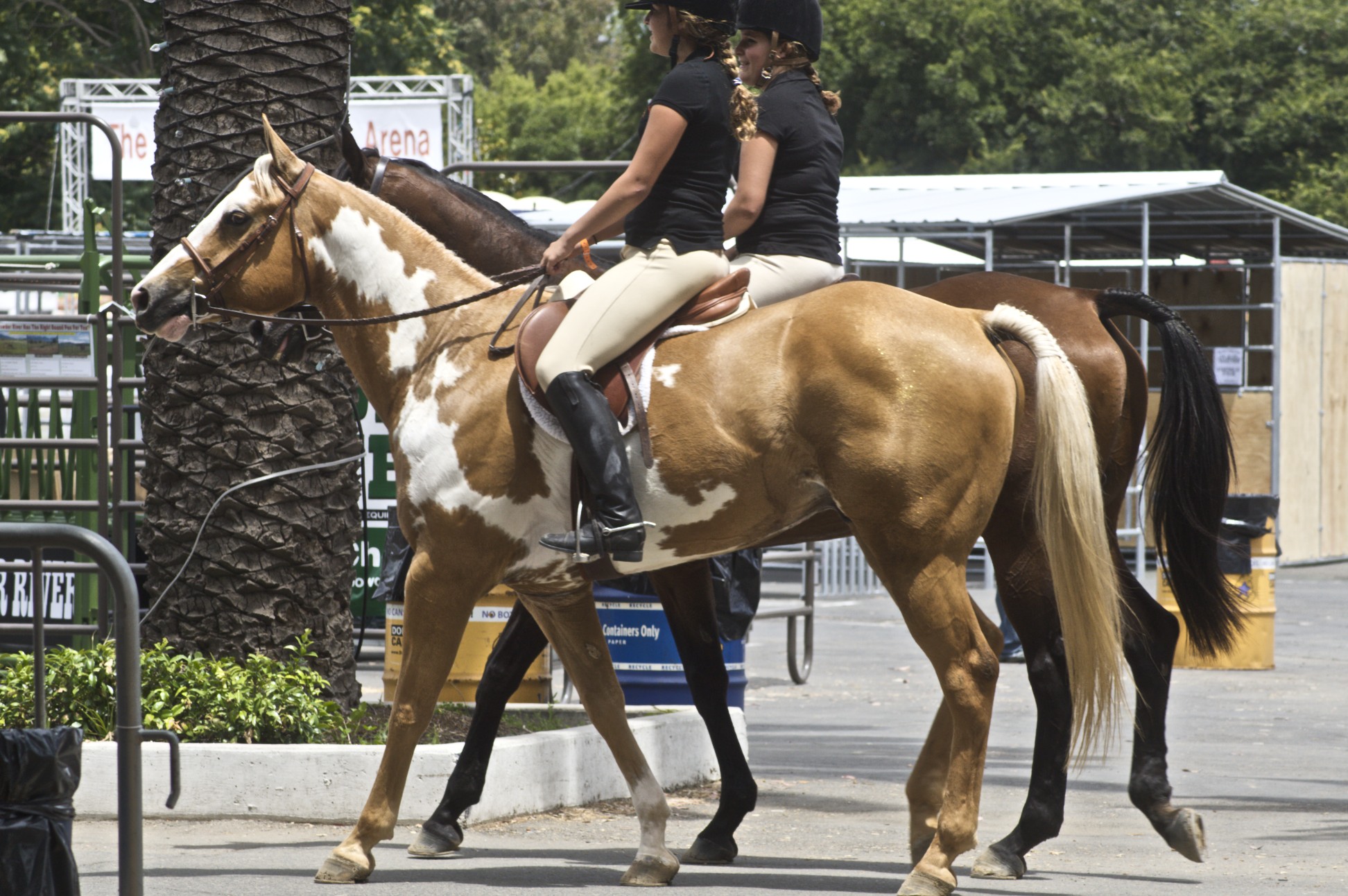
Skewbald is a pinto color term. Skewbald includes white any other patches of color except for black.
This can also include tri-colors, which is patches of white over any two other colors. Only in this circumstance, may black be included.
Piebald
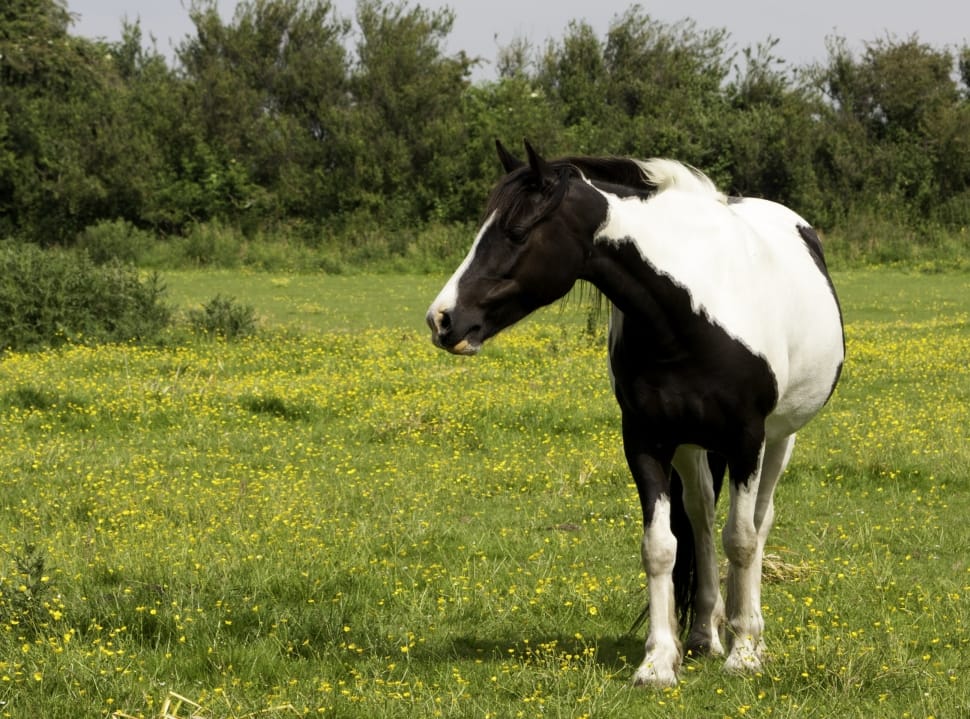
Piebald is another color term.
Piebald is white patches only over a black coat.
So a black and white horse.
Overo

Overo is a pinto pattern term.
Overos can have any solid body color
These horses usually have bald faces with white markings that are usually jagged moving horizontally along the horses body.
These white markings don’t commonly show up across the horse’s back or legs.
The horse’s body usually has more color than white patches and is sometimes seen with blue eyes.
There are variations of overo including “frame overo”, “splashed white” and “sabino overo.”
Medicine Hat
The medicine hat is a marking commonly seen in overos, but it can be seen in any of the pinto patterns.
The horse typically has a bald face with a marking covering the top of it’s head that makes it look like it is wearing a hat.
Splashed White

The splashed pant looks as if it was dipped into a horse size tub of white paint.
The legs are white and the belly is white. How high up the white splash goes can range from horse to horse. These horses usually have white bald faces with blue eyes.
Sabino

There are only slight patches on belly, high leg markings, and wide blazes or other markings on the face.
Sometimes there is a roaning pattern around the edge of these patches and some lone roaning patches.
This is why robicano is often confused with Sabino.
Sabinos can sometimes be classified with Overo, known as “sabino overo,” when they also have the classic jagged overo patches and sometimes the bald face.
Robicano
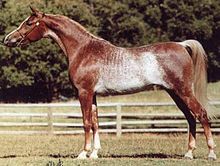
Robicano is also known as “white ticking.”
This is when the horse is not fully roan, but has only roan patches which is not an actual pinto pattern.
This can be confused with sabino which has white patches that may have roaning around the edges, or white patches and roaning patches on a horse.
Tobiano
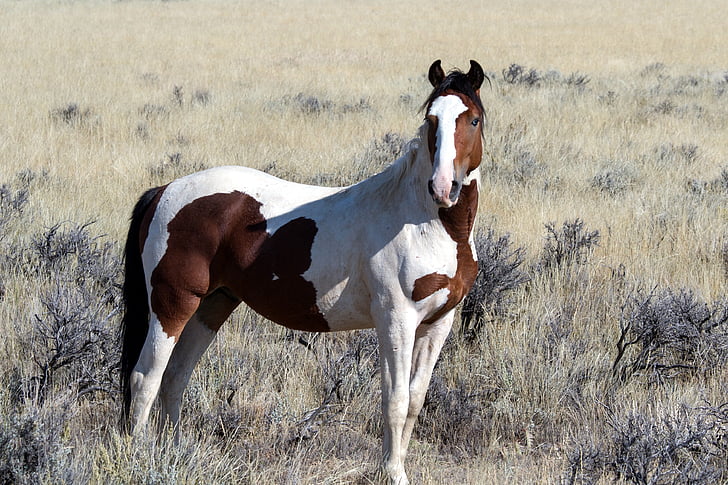
Tobiano pinto horse usually has normal face markings, the white patches are more rounded off and vertically placed, legs tend to be white.
Tobiano tend to have more white than color on the body.
Bay and white Tobianos tend to be called tricolored.
Tovero

The tovero pattern is a mixture of the overo pattern and the tobiano pattern. This pattern is rare in pintos.
Leopard Complex Gene Or Spotted Coat Patterns
This is a group of coat patterns that generally have a spotted coat. However, there are horses with leopard complex genes that are solid in color.
Other characteristics with horses that have this gene are mottled skin (speckled skin with light and dark color) around the lips, eyes, and genitals, vertically striped hooves, and a white sclera of the eye.
Breeds that have the leopard complex include Appaloosas, Knabstrupper, Ponies Of The Americas, and the Noriker.
Blanket
Blanket pattern has white over the hips that can extend all the way to the neck and tail.
Spots in the white area are the same color as the horses coat. Sometimes the blanket area has no spots.

Varnish Roan
This looks similar to the roan but has no relation. There are white hairs mixed throughout the body, neck legs and head.
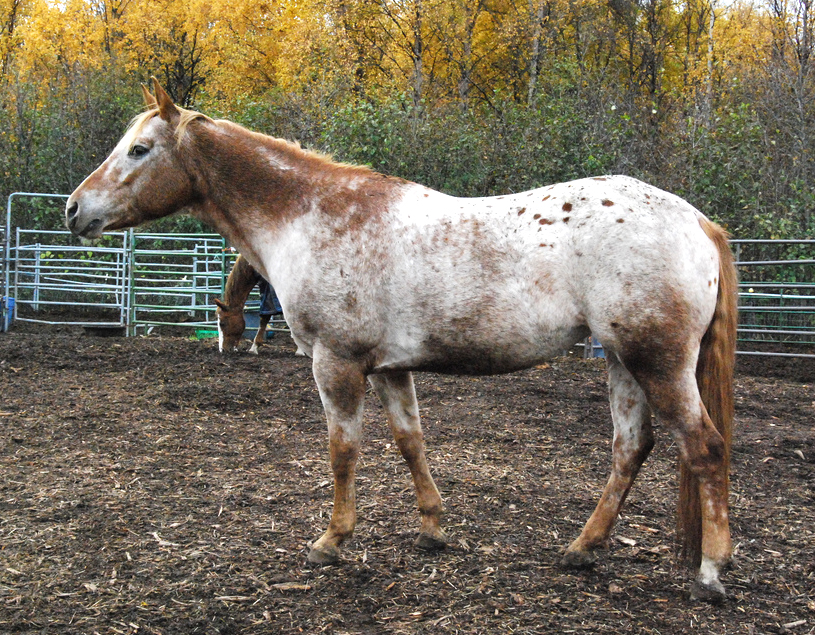
Frost
Frost pattern is similar to the varnish pattern but the white hairs only mix in on the body and not the legs or head.
The picture below does have some white mixing in on the head, so more likely a varnish pattern.
But this was the closest copyright free image I could find that closely resembles a frost pattern.
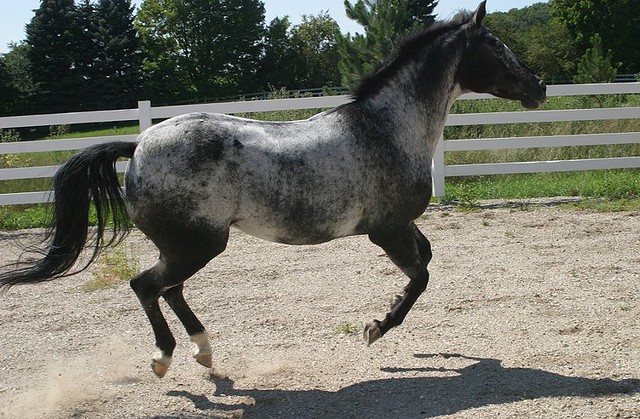
Snowflake
These are white spots on a dark body. More spots tend to appear as the horse ages.

Leopard
Leopard pattern has dark spots all over the body in different sizes. These horses tend to look like dalmatians.

Few Spot Leopard
The spots on these horses are much smaller and not to be confused with a flea-bitten grey. They are nearly white with almost no spots at birth.

Horse Coat Color & Pattern FAQS
WHAT ARE THE 5 BASIC HORSE COAT COLORS?
1. Bay
2. Chestnut
3. Black
4. Seal Brown
5. Grey
However, the base colors of horses are bay, chestnut, and black, all other colors are variations of these 3 colors. Bay is a modification of black hence the black points but still considered a base color. White horses are lacking pigment in skin and coat.
WHAT IS A LIGHT COLORED HORSE CALLED?
There are many light-colored horse colors such as palomino, dun, light bay, buckskin, cremello, pearl, champagne, grey, white, and more. There are many different light-colored horse coats.
WHAT HORSE BREED HAS THE WIDEST RANGE OF COLORS
There are two horse breeds with a very wide range of colors the American Quarter Horse and Mustang come in just about every color out there. Though not every pattern.
HOW DO YOU DETERMINE WHAT COLOR A FOAL WILL BE?
You can only make an educated guess because usually there is more than one possible outcome. Check out this equine color calculator.
WHAT IS THE RAREST COLOR OF A HORSE?
Some people say true white horses are one of the rarest. I honestly don’t know “the rarest color.” But if I had to take an educated guess, I would say a brindle colored horse. Brindle coat color can be inherited and also not inherited and they are very rare. There is some but not a lot of information on the internet about the brindle colored horse.
WHAT IS THE MOST COMMON COAT COLOR IN HORSES?
The most common horse color is bay.
WHAT DO YOU CALL A BLACK HORSE?
A black horse is just a horse with a black coat color. Friesians are a breed of horse that almost exclusively come in black.
WHAT DO YOU CALL A BROWN HORSE?
Brown horses are typically called seal brown and look almost black or dark brown with light brown highlights around eye muzzle and flank.
Bay horses are reddish-brown horses with black points including mane and tail.
Chestnut is a coppery reddish brown color that has a similar or light color mane and tail, with no black points.
WHAT IS THE DIFFERENCE BETWEEN A CHESTNUT AND BAY HORSE?
The mane difference is that a chestnut horse has no black in the coat and has same color mane and tail, while a bay horse has a black mane and tail as well as black points, muzzle, ear tips, and legs.
WHAT IS A BLACK HORSE WITH A WHITE MANE AND TAIL CALLED?
A black horse with a white mane and tail would be a silver dapple horse with a black base coat.
HOW CAN A HORSE BE CALLED AN APPALOOSA IF THEY HAVE NO SPOTS?
Appaloosa’s can be solid in color. An appaloosa is a breed of horse not a coat pattern.
Cheers, Kacey
Related Blog Posts
- Complete Guide To Horse Coat Colors & Patterns: FAQ’s Included
- Bay Horses 101: Learn All About The Beautiful Shades Of Bay
- 16 Dapple Grey Horse Facts With Beautiful Pictures | Breeds List | Resources
- What Is A Flea Bitten Grey Horse? Grey Horse Breeds, Facts, Colors & Photos
- Learn 10 Facts, Differences & Color Shades Of Buckskin & Dun Horses
- 27 Interesting Palomino Horse Facts With Beautiful Pictures & Some Extras
- Horse Face and Leg Markings Chart
- Horse Coat Patterns for the American Paint Horse

